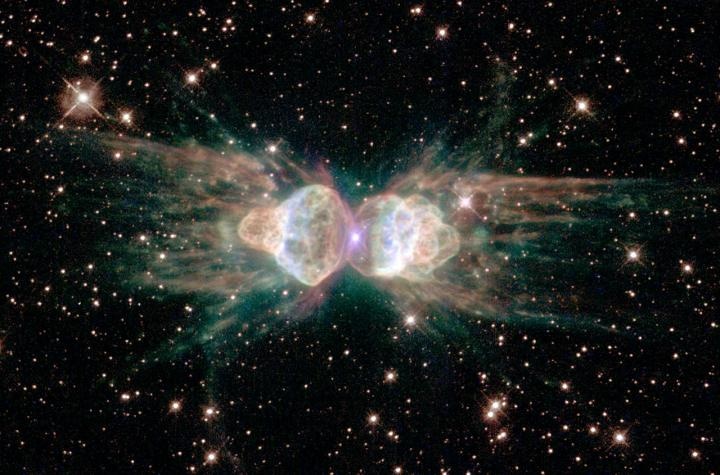May 21 2018
A rare laser emission, which hints at the existence of a double star system concealed at the center of the “spectacular” Ant Nebula, has been discovered by an international team of astronomers.
 The Ant Nebula, as imaged by the NASA/ESA Hubble Space Telescope, resembles the head and body of a garden ant. In reality, it’s the result of a dying sun-like star and complex interactions of material at its heart. (Image credit: NASA, ESA, and the Hubble Heritage Team (STScI/AURA))
The Ant Nebula, as imaged by the NASA/ESA Hubble Space Telescope, resembles the head and body of a garden ant. In reality, it’s the result of a dying sun-like star and complex interactions of material at its heart. (Image credit: NASA, ESA, and the Hubble Heritage Team (STScI/AURA))
Associated with the demise of a star, this highly unusual phenomenon was discovered through observations made by the Herschel space observatory of the European Space Agency (ESA).
Toward the end of their lives, stars with low to middle weight (e.g. Sun) eventually get denser, white dwarf stars. During this process, their outer layers of dust and gas are liberated into space, thereby forming a kaleidoscope of intricate patterns termed planetary nebula. It is anticipated that one day, our Sun will form such a planetary nebula.
Nebulae are interstellar clouds of helium, hydrogen, dust, and other ionized gases. The Ant Nebula is named after its twin lobes that look similar to the head and body of an ant.
From the latest Herschel observations, it can be seen that the spectacular death of the central star in the core of the Ant Nebula is even more dramatic than observed from its colorful display in visible images, for example, those taken by the NASA/ESA Hubble Space Telescope.
The new data indicates that intense laser emission is also emitted from the core of the Ant Nebula. Lasers are very familiar here on earth in day-to-day life, whether for communications and healthcare or for special visual effects in music concerts. In space, one can detect laser emission at extremely distinctive wavelengths and only under specific conditions. Very few infrared space lasers are familiar.
Incidentally, Donald Menzel, the astronomer who was the first to observe and classify this specific planetary nebula in the 1920s (it is officially named Menzel 3 after him), was one among the first to propose that under specific conditions, natural “light amplification by stimulated emission of radiation”—from which the acronym “laser” is derived - could take place in nebulae in space. This was much ahead of the discovery of lasers in labs.
Elucidating on the new outcomes, lead author of the paper Dr. Isabel Aleman stated, “We detected a very rare type of emission called hydrogen recombination laser emission, which is only produced in a narrow range of physical conditions.”
“Such emission has only been identified in a handful of objects before and it is a happy coincidence that we detected the kind of emission that Menzel suggested, in one of the planetary nebulae that he discovered.”
For this laser emission occur, there must be highly dense gas located very near to the star. When the observations were compared with models, it was found that the density of the gas from which the laser emission occurred is about 10,000 times more than the gas observed in typical planetary nebulae and in the lobes of the Ant Nebula itself.
In general, the region close to the extinct star (close here means approximately the distance of Saturn from the Sun) is absolutely empty since its material is ejected outward. Any gas that is left out would eventually fall back onto it.
According to Prof Albert Zijlstra, co-author of the study, from the Jodrell Bank Centre for Astrophysics in the School of Physics and Astronomy, “The only way to keep such dense gas close to the star is if it is orbiting around it in a disc. In this nebula, we have actually observed a dense disc in the very center that is seen approximately edge-on. This orientation helps to amplify the laser signal.”
“The disc suggests there is a binary companion because it is hard to get the ejected gas to go into orbit unless a companion star deflects it in the right direction. The laser gives us a unique way to probe the disc around the dying star, deep inside the planetary nebula.”
The anticipated second star, concealed at the center of the Ant Nebula, has not yet been observed by astronomers.
Göran Pilbratt, ESA’s Herschel project scientist, said: “It is a nice conclusion that it took the Herschel mission to connect together Menzel’s two discoveries from almost a century ago.”